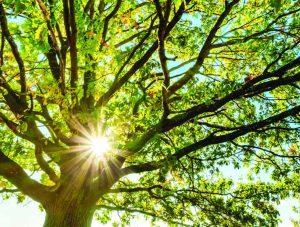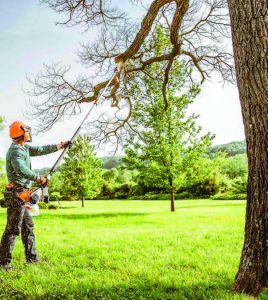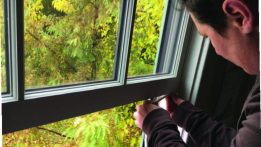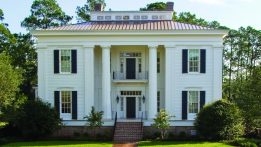 Yes! Trees have life spans, and they become more risky as they age. Do you understand what phase of life your trees are in? This really matters and will determine what your trees need to maintain health and stability.
Yes! Trees have life spans, and they become more risky as they age. Do you understand what phase of life your trees are in? This really matters and will determine what your trees need to maintain health and stability.
It is actually quite interesting how much people and trees are alike.
Trees start off growing tall, skinny and flexible like teenagers. Then, in their middle age they stiffen up and widen out around the middle. As they reach old age, they go thin up top, their vascular system slows down, their joints break down and they are more likely to fall over. Ha! Sounds familiar! In Tallahassee and the surrounding areas, many tree species have life spans similar to that of people—80-100 years of strong stable growth followed by decline, deterioration and then death.
How does this affect me? In older (40-50 years or more) highly developed neighborhoods like Killearn Estates, Betton, Indian Head Acres or Frenchtown, the homes are aging with the trees. Mature tree pruning methods and tree removal are more commonly deployed. We see more trees and larger trees being removed from these neighborhoods. Sometimes it feels unjust. On the other hand, sometimes we protect or ignore the trees too long and several fall. Then, human emotions take over and a clear cut of the yard happens or some drastic approach. Arborists should be playing an important role in counseling your decision making, so that you do not cut too much or too little.
In newer neighborhood developments (around 25 years or newer) like Southwood, Ox Bottom or Buck Lake area neighborhoods, the trees are still experiencing lingering construction related health issues, and the newly planted trees need young tree pruning methods applied. Proper tree planting advice is important as you will notice sidewalks being lifted by large trees planted in small areas. Small bushy trees that are growing close to homes or impeding visibility of stop signs will need more commonly recurring pruning maintenance than the mature stand of trees which usually only need dead limbs pruned out. Sometimes developments need a lot of fill dirt to achieve proper grades or watersheds. It is common that trees planted in this nutrient depleted soil do not grow well. It is also common that young trees are not planted properly. Bad soil and improper planting = a tree that will not establish = wasted money.
A certified arborist understands these cycles of life and knows what to prescribe to your trees at the right time.
A young tree will need structural pruning. When this is done properly, the tree will have a better structural foundation to establish into a strong and healthy middle-aged tree. Structural pruning should address any co-dominant stems, included bark, overextended limbs, rubbing limbs and conflicts with people and structures. The earlier this type of pruning is applied, the better. Pruning at planting is best practice. When a tree is young, it will tend to grow more quickly than an older tree, so it is important to prune every one to two years until the desired structure is achieved. Pruning can be more aggressive on a younger tree than older trees. Small trees are easy to prune and, therefore, more cost effective than waiting for the tree to grow larger while it is developing defects.
A middle-aged tree that was pruned for structure when it was younger will need less maintenance as it ages. That is a big deal because middle-aged trees are now larger and will require more work and more equipment to care for them, meaning they will be more costly. To go on, pruning cuts are creating a wound that the tree has to react to and heal from. Pruning work can be bad for a tree if it is done improperly. As the tree grows larger, the pruning cuts will naturally be larger cuts. Larger cuts make larger wounds. Wounds will eventually turn to rot and decay as the tree ages into maturity, so it is important to minimize how large pruning cuts are made. Most pruning cuts should be in the outer region of the canopy, not up against the trunk when possible. A middle-aged tree is in its prime of life, growing strong, yet still flexible and full of nutrient health.
 As a tree rounds the corner of middle aged into the years of maturity, it becomes more feeble. This is when a tree needs to be monitored for safety the closest. A tree that was properly pruned for structure will have fewer defects to watch out for, but, just like people, as a tree ages, the defects develop. Defects get worse as time passes. Some of this can be attributed to the vascular system slowing down. Nutrient flow isn’t as strong and decaying areas are now drying out and spreading deeper into the once sound wood. The old tree loses its ability to compartmentalize the spread of decay in the wood. Pieces of the tree might break or fall off. Sometimes the entire tree may even fall over. These trees are the most affected when a storm blows through. The elderly trees tend to be broken or knocked over by the wind more commonly than middle-aged or young trees. So, this is the age of a tree’s lifespan that raises concern if the tree has a target.
As a tree rounds the corner of middle aged into the years of maturity, it becomes more feeble. This is when a tree needs to be monitored for safety the closest. A tree that was properly pruned for structure will have fewer defects to watch out for, but, just like people, as a tree ages, the defects develop. Defects get worse as time passes. Some of this can be attributed to the vascular system slowing down. Nutrient flow isn’t as strong and decaying areas are now drying out and spreading deeper into the once sound wood. The old tree loses its ability to compartmentalize the spread of decay in the wood. Pieces of the tree might break or fall off. Sometimes the entire tree may even fall over. These trees are the most affected when a storm blows through. The elderly trees tend to be broken or knocked over by the wind more commonly than middle-aged or young trees. So, this is the age of a tree’s lifespan that raises concern if the tree has a target.
There’s another valid point. Does the tree in debate have a target? If not, then you can let nature run its course. On the other hand, if the tree could fall and land onto a person, a car, a house, or any target, then you should address the tree and have it inspected by a certified arborist. The court of law sometimes finds people negligent in certain tree related incidents.
Let’s back up for a minute and cover a couple basics that I missed.
There is a big difference between “trimming” and “pruning.” Remember it this way: hedge trimmers=“trimming” and hand pruners= “pruning.”
Pruning is making very selective cuts to a tree, shrub or plant for a very intentional purpose. Pruning can be done with other tools, not just hand pruners but also chainsaws, hand saws, pole saws or loppers. Trimming falls more into the category of non-discriminate cutting to achieve shape or uniformity. Trimming is practiced most commonly for shrubs and small plants while pruning is best practice for larger species. Please do not “trim” a large, majestic tree. I hope that makes good philosophical sense. Tree companies of Tallahassee, let’s make this common practice.
“Water is life.”
That’s right. I said it. Water is life for people and trees. Keep them watered. A tree is just like a larger version of a wilting houseplant with a slower reaction time and the ability to store more water and nutrients. When drought occurs, stress is induced, and by the time we humans notice our friend suffering, it will be hard to recover—not impossible but concerning.
Trees are like people. We cut the umbilical cord when we plant them, we feed them the bottle during initial watering phases, and they need to drink often. The vascular system is strong. We send them to school to be trained for structure and future performance. They grow tall. They widen out. They become strong and middle-aged. They mature and become wise. Adapting to a life of evolving changes and struggles. Their developed root system ties with their neighbors for community. They get sick, and when they fall, others hold them up. They reproduce and die creating the cycle that we know as…Life. ![]()
Mike Cross
Certified Arborist, Certified Tree Worker, Qualified Tree Risk Inspector, Lover of Trees




